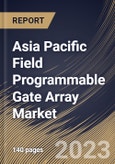The field programmable gate array (FPGA) technology, characterized by its reconfigurable nature and versatility, has become indispensable across diverse industries, revolutionizing the digital circuit design and deployment landscape. The necessity for FPGAs stems from their unique ability to offer customizable hardware solutions, enabling users to reprogram the device after manufacturing to suit specific application requirements. This adaptability aligns with the growing demand for agile and customizable solutions in today's rapidly evolving technological landscape.
Recent developments in FPGA technology have showcased significant strides in enhancing performance, efficiency, and functionality. Innovations in manufacturing processes, such as the transition to smaller semiconductor nodes and advanced materials, have led to the development of more powerful and energy-efficient FPGA devices. Moreover, advancements in architectural design, including the integration of embedded processors, high-speed transceivers, and specialized hardware accelerators, have expanded the capabilities of FPGAs, making them suitable for an increasingly diverse range of applications.
As a result of cost-effectiveness, reduced power consumption, and quicker turnaround times in comparison to application-specific integrated circuits (ASICs), FPGA technology is undergoing a discernible period of constant development. The increasing prevalence of FPGAs can be attributed to their intrinsic adaptability, which permits circuit reconfiguration after implementation. As designers are able to modify their creations even after the deployment of the product in the field, this trend is anticipated to have a significant impact in the coming years by enhancing responsiveness and adaptability. During the forecast period, this is likely to continue to be a significant driver.
Several countries in the region are investing in smart city initiatives, leveraging advanced telecom infrastructure. These projects involve the integration of IoT devices, data analytics, and connectivity solutions to enhance urban living, transportation, and public services. As reported by Invest India, the Government has authorized the auction of IMT/5G spectrum to facilitate the deployment of 5G services throughout the nation to accelerate digital connectivity. $18.77 billion was successfully raised through this auction by the end of July 2022. According to data released by the Ministry of Communication of India in 2022, The Indian Telegraph Right of Way (Amendment) Rules, 2022 will enable the expeditious and simplified implementation of telegraph infrastructure, thereby facilitating the rapid rollout of 5G. Therefore, the rising 5G expansion in major countries of the Asia Pacific region will boost the demand for field programmable gate arrays in the region.
The China market dominated the Asia Pacific Field Programmable Gate Array Market, by Country in 2022, and would continue to be a dominant market till 2030; thereby, achieving a market value of $2,419.5 Million by 2030. The Japan market is exhibiting a CAGR of 9.8% during (2023 - 2030). Additionally, The India market would experience a CAGR of 11.3% during (2023 - 2030).
Based on Technology, the market is segmented SRAM, Antifuse, Flash, EEPROM, and Others. Based on Application, the market is segmented into Telecom, Automotive, Industrial, Consumer Electronics, Data Processing, Military & Aerospace, and Others. Based on Type, the market is segmented into Low-end, Mid-range, and High-end. Based on countries, the market is segmented into China, Japan, India, South Korea, Singapore, Malaysia, and Rest of Asia Pacific.
The market research report covers the analysis of key stake holders of the market. Key companies profiled in the report include Cobham Advanced Electronic Solutions, Intel Corporation, Taiwan Semiconductor Manufacturing Company Limited, Broadcom, Inc., Achronix Semiconductor Corporation, QuickLogic Corporation, Microsemi Corporation (Microchip Technology), United Microelectronics Corporation, Xilinx, Inc. (Advanced Micro Devices, Inc), Lattice Semiconductor Corporation.
Scope of the Study
Market Segments Covered in the Report:
By Technology (Volume, Thousand Units, USD Billion, 2019 to 2030)- SRAM
- Antifuse
- Flash
- EEPROM
- Others
- Telecom
- Automotive
- Industrial
- Consumer Electronics
- Data Processing
- Military & Aerospace
- Others
- Low-end
- Mid-range
- High-end
- China
- Japan
- India
- South Korea
- Singapore
- Malaysia
- Rest of Asia Pacific
Key Market Players
List of Companies Profiled in the Report:
- Cobham Advanced Electronic Solutions
- Intel Corporation
- Taiwan Semiconductor Manufacturing Company Limited
- Broadcom, Inc.
- Achronix Semiconductor Corporation
- QuickLogic Corporation
- Microsemi Corporation (Microchip Technology)
- United Microelectronics Corporation
- Xilinx, Inc. (Advanced Micro Devices, Inc)
- Lattice Semiconductor Corporation
Unique Offerings
- Exhaustive coverage
- The highest number of Market tables and figures
- Subscription-based model available
- Guaranteed best price
- Assured post sales research support with 10% customization free
Table of Contents
Companies Mentioned
- Cobham Advanced Electronic Solutions
- Intel Corporation
- Taiwan Semiconductor Manufacturing Company Limited
- Broadcom, Inc.
- Achronix Semiconductor Corporation
- QuickLogic Corporation
- Microsemi Corporation (Microchip Technology)
- United Microelectronics Corporation
- Xilinx, Inc. (Advanced Micro Devices, Inc)
- Lattice Semiconductor Corporation
Methodology

LOADING...








